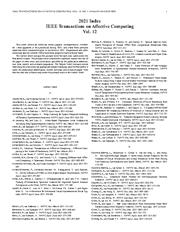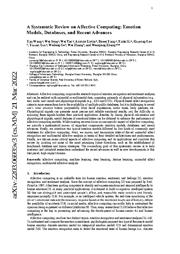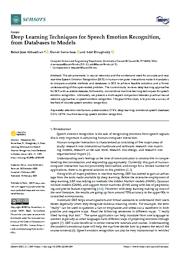A copy of this work was available on the public web and has been preserved in the Wayback Machine. The capture dates from 2022; you can also visit the original URL.
The file type is application/pdf.
Filters
ASMMC21: The 6th International Workshop on Affective Social Multimedia Computing
2021
Proceedings of the 2021 International Conference on Multimodal Interaction
Although much progress have been made in traditional multimedia research on multimedia content analysis, indexing, and retrieval based on subjective concepts such as emotion, aesthetics, and preference ...
This workshop served as a successful step towards this goal and attracted contributions from different research disciplines on the analysis of affective signals in interaction (multimodal analyses enabling ...
Time • 14:30 -15:30 Keynote Speaker II • 15:30 -16:00 Coffee Break • 16:00-17:40 Multimodal Emotion Synthesis
ACCEPTED PAPERS AND ABSTRACTS BERT Based Cross-Task Sentiment Analysis with Adversarial Learning ...
doi:10.1145/3462244.3480980
fatcat:6mkbgunpgbg6va6j4eucvqf7ui
2021 Index IEEE Transactions on Affective Computing Vol. 12
2022
IEEE Transactions on Affective Computing
-Dec. 2021 900-912 Improving Cross-Corpus Speech Emotion Recognition with Adversarial Discriminative Domain Generalization (ADDoG). ...
-March 2021 53-65 Generative adversarial networks Improving Cross-Corpus Speech Emotion Recognition with Adversarial Discriminative Domain Generalization (ADDoG). Gideon, J., +, TAFFC Oct. ...
doi:10.1109/taffc.2021.3132546
fatcat:qjxf4chxybaelmyrlnhiesanai
Domain Adversarial Network for Cross-Domain Emotion Recognition in Conversation
2022
Applied Sciences
To alleviate the problem, we propose a Domain Adversarial Network for Cross-Domain Emotion Recognition in Conversation (DAN-CDERC) model, consisting of domain adversarial and emotion recognition models ...
Then DAN-CDERC transfers the learned domain invariant dialogue context knowledge from the domain adversarial model to the emotion recognition model to assist in modeling the dialogue context. ...
[36] treated emotion recognition and culture recognition as two adversarial tasks for cross-culture emotion recognition to address the problem of generalization across different cultures. ...
doi:10.3390/app12115436
fatcat:c3w7bqnaqbbmxmmyjccqtuf7he
Self Supervised Adversarial Domain Adaptation for Cross-Corpus and Cross-Language Speech Emotion Recognition
[article]
2022
arXiv
pre-print
Despite the recent advancement in speech emotion recognition (SER) within a single corpus setting, the performance of these SER systems degrades significantly for cross-corpus and cross-language scenarios ...
Recent studies focus on utilising adversarial methods to learn domain generalised representation for improving cross-corpus and cross-language SER to address this issue. ...
[59] use transformer-based SSL to improve the performance of multimodal emotion recognition. ...
arXiv:2204.08625v1
fatcat:7pbqre3orffw5lg726vdytikpe
Deep Cross-Corpus Speech Emotion Recognition: Recent Advances and Perspectives
2021
Frontiers in Neurorobotics
Automatic speech emotion recognition (SER) is a challenging component of human-computer interaction (HCI). ...
This paper aims to provide an up-to-date and comprehensive survey of cross-corpus SER, especially for various deep learning techniques associated with supervised, unsupervised and semi-supervised learning ...
To further improve emotion recognition, it is thus interesting to combine speech clues with other modalities such as visual, text, and physiological clues for multimodal cross-corpus. ...
doi:10.3389/fnbot.2021.784514
pmid:34912204
pmcid:PMC8666588
fatcat:mviw3j34xvapfac74ekrwmh7wa
A Systematic Review on Affective Computing: Emotion Models, Databases, and Recent Advances
[article]
2022
arXiv
pre-print
., emotion recognition and sentiment analysis). ...
baseline dataset, fusion strategies for multimodal affective analysis, and unsupervised learning models. ...
Adversarial learning is widely used to improve the robustness of models by augmenting data [206, 291] and cross-domain learning [156, 192] . ...
arXiv:2203.06935v3
fatcat:h4t3omkzjvcejn2kpvxns7n2qe
Unsupervised Adversarial Domain Adaptation for Cross-Lingual Speech Emotion Recognition
[article]
2020
arXiv
pre-print
Cross-lingual speech emotion recognition (SER) is a crucial task for many real-world applications. ...
Therefore, in this paper, we propose a Generative Adversarial Network (GAN)-based model for multilingual SER. ...
CONCLUSIONS In this paper, we proposed an unsupervised adversarial domain adaption approach for developing deep learning models for cross-lingual speech emotion recognition tasks. ...
arXiv:1907.06083v4
fatcat:pbxexa5ydzdqlj63spueap5cga
Cross-Language Speech Emotion Recognition Using Multimodal Dual Attention Transformers
[article]
2023
arXiv
pre-print
Despite the recent progress in speech emotion recognition (SER), state-of-the-art systems are unable to achieve improved performance in cross-language settings. ...
In this paper, we propose a Multimodal Dual Attention Transformer (MDAT) model to improve cross-language SER. ...
a self-adjusting fusion representation learning model for unaligned text-audio sequences, and HCAM [81] that uses a hierarchical cross attention model for multimodal emotion recognition. ...
arXiv:2306.13804v3
fatcat:dwwu32dbovg6ljbxakb7fod3ky
Multitask Learning from Augmented Auxiliary Data for Improving Speech Emotion Recognition
[article]
2022
arXiv
pre-print
Despite the recent progress in speech emotion recognition (SER), state-of-the-art systems lack generalisation across different conditions. ...
We comprehensively evaluate the proposed framework in the following settings: (1) within corpus, (2) cross-corpus and cross-language, (3) noisy speech, (4) and adversarial attacks. ...
We select 30 % of the MSP-IMPROV data for parameter TABLE 3 : Cross-corpus evaluation results for emotion recognition. ...
arXiv:2207.05298v1
fatcat:gvjhz5fluvctlmhlt7gfxn4pty
A Review of Generalizable Transfer Learning in Automatic Emotion Recognition
2020
Frontiers in Computer Science
In this manuscript, we will describe fundamental concepts in the field of transfer learning and review work which has successfully applied transfer learning for automatic emotion recognition. ...
We will finally discuss promising future research directions of transfer learning for improving the generalizability of automatic emotion recognition systems. ...
Transfer Learning for Cross-Cultural and Cross-Linguistic Emotion Recognition Emotions can be expressed in different ways across different cultures and languages. ...
doi:10.3389/fcomp.2020.00009
fatcat:o3ya5n2nvjbptnxkqahpgrluie
Multi-Task Semi-Supervised Adversarial Autoencoding for Speech Emotion Recognition
[article]
2020
arXiv
pre-print
The proposed model is rigorously evaluated for categorical and dimensional emotion, and cross-corpus scenarios. ...
To maximise the benefit of multi-task learning, we further use an adversarial autoencoder (AAE) within our framework, which has a strong capability to learn powerful and discriminative features. ...
CONCLUSIONS In contrast with previous studies, this article proposes semisupervised multi-task learning using adversarial autoencoders for speech emotion recognition (SER). ...
arXiv:1907.06078v5
fatcat:drhb3dfjsraxxkt73dnncqhsqa
Utilizing AI and Machine Learning for Human Emotional Analysis through Speech-to-Text Engine Data Conversion
2022
Design of Single Chip Microcomputer Control System for Stepping Motor
By scrutinizing emotions conveyed in spoken language, artificial intelligence (AI) and machine learning (ML). ...
Artificial Intelligence (AI) and Machine Learning (ML) technologies have revolutionized various domains, and one of their fascinating applications is in analyzing human emotions through speech-to-text ...
Utilization of Deep Learning Models for Emotion Recognition Deep learning models have revolutionized emotion recognition from speech-to-text data. ...
doi:10.47363/jaicc/2022(1)145
fatcat:pugqxpyyurbvfoipsapa5ex33u
Synthesizing Synergies: Unleashing Cross-Modal Neural Architectures for Seamless Multi-Task Learning
2023
Zenodo
This article delves into the innovative realm of cross-modal neural architectures, focusing on their potential to revolutionize multi-task learning. ...
The title, "Synthesizing Synergies: Unleashing Cross-Modal Neural Architectures for Seamless Multi-Task Learning," encapsulates the essence of the exploration. ...
Moreover, there are also cross-modal architectures that have been applied to multimodal sentiment analysis. These bring the emotions of text and images together effectively. ...
doi:10.5281/zenodo.10512767
fatcat:jyaxvvjcifesxakr4mfa6tjokq
Emotion Interaction Recognition Based on Deep Adversarial Network in Interactive Design for Intelligent Robot
2019
IEEE Access
INDEX TERMS Emotional interaction, adversarial network, deep learning, softmax layer, artificial intelligence, interaction robot, semantic feature. ...
suitable for dimension emotion recognition of large-scale data. ...
With adversarial training literature [13] can promote the feature fusion of emotion state and images, and make network learn a more effective common subspace. ...
doi:10.1109/access.2019.2953882
fatcat:t334otxcrrac5ectsjgzszgoym
Deep Learning Techniques for Speech Emotion Recognition, from Databases to Models
2021
Sensors
The current study reviews deep learning approaches for SER with available datasets, followed by conventional machine learning techniques for speech emotion recognition. ...
The goal of this study is to provide a survey of the field of discrete speech emotion recognition. ...
Crowd-Sourced Emotional Multimodal Actors Dataset (CREMA-D) CREMA-D [59] is a dataset made for multimodal emotion recognition tasks. ...
doi:10.3390/s21041249
pmid:33578714
pmcid:PMC7916477
fatcat:nj5ihjhvnfcxtk7hu3n4zx4bka
« Previous
Showing results 1 — 15 out of 807 results











